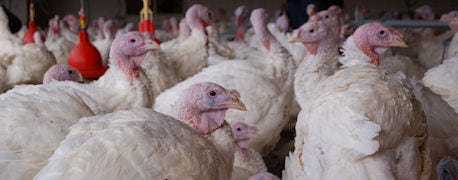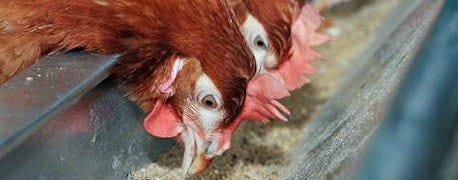
The spring of 2015 outbreak of avian influenza that resulted in quarantine and surveillance measures in four counties in Kansas and the depopulation of a small flock in Crawford County and of a large commercial flock in Leavenworth County appears to be over, animal health officials say.
Movement restrictions on poultry and eggs that had been part of the response have been lifted in all four counties and no further instances of sick birds have occurred.
That doesn't mean that the Kansas Department of Agriculture's Animal Health Division is heaving a sigh of relief and letting down their guard.

TURKEYS SUSCEPTIBLE: Commercial turkey flocks in several states, including Kansas, have fallen victim to this spring's outbreaks of avian influenza.
That's because the source of the virus that has caused concern for poultry producers from Arkansas to Minnesota to Missouri and Kansas, comes from wild birds and is transmitted from the droppings of those birds along the nation's major migratory flyways.
"We know that the birds tend to take the same pathways north and south, but that once they reach their northern summer spots, they all intermingle. We don't yet know what that means for this virus over the summer. We know there is a huge viral load out there and that flu viruses tend to be mutate. That makes it reasonable to expect that this virus, in some form, will be something we have to watch for during the fall migratory season," said deputy animal health commissioner, Justin Smith. "All of our producers know to stay vigilant and to keep their biosecurity measures in place."
Smith said scientists across the country are working to learn more about this strain of avian flu and to try to get ahead of it.

BIRD FLU: The outbreak of avian influenza that caused depopulation of a small, backyard flock in Crawford County and a large, commercial turkey flock in Leavenworth County appears to be over -- at least for now.
"There is no reason for us to think that we won't have more issues in the fall. We can't let our guard down," he said. "Our producers are ready to do what they need to from bringing backyard birds inside to stepping up their biosecurity measures to insure that the people caring for those indoor birds don't drag the virus in on their shoes or equipment."
At the same time, the viral load from the spring outbreak will lessen as we get into the summer months. The virus tends to last longer in cool, wet weather and die out when the weather turns hot and dry, reducing the risk of birds becoming contaminated during the summer.
'Real' practice helps for next time
When it comes to planning for an outbreak of animal disease, county and state emergency management officials are always busy. Exercises to plan response coordination are conducted throughout the year.
But for Sandy Johnson, emergency management director for KDA, the bird flu outbreak was the first time in her six years with the department that she has dealt with a real outbreak.
VIRUS IN WILD: Wild migratory birds appear to be the source of the avian influenza viruses that are affecting poultry in the U.S. Flocks that are out on pasture are in the greatest danger because they are more likely to be exposed to wild birds or their droppings.
"We plan all the time with exercises, but there is always a sense of artificiality in those," she said. "The real world experience of really doing the job is very helpful. We learned a lot, both about what we were doing right and what we could do better."
An actual deployment of personnel into the field to do surveillance and meet with other partners in dealing with disease outbreak, including the Kansas Department of Health and Environment, which kicks into gear if there is a human component to an outbreak, is extremely valuable, Johnson said.
"Most of what we practiced worked in real life," she said. "But we do know that we need to always be working on being more efficient, about making the best possible use of peoples' skills, managing the data we collect and trying to be the best we can at what we have to do."
She said the department utilized staff members from other programs to help them provide the number of people needed to take care of multiple counties and relied on county partners to help boost their numbers as well.
"We never assume that an outbreak will be in just one spot. We train for dealing with several locations at once. In a large outbreak, we would have to turn to our colleagues from other states and make sure that our workers are trained to respond quickly," Johnson said.
Smith said that the department worked to contact as many bird caregivers as possible, working with communications staff, media and social media and anyone else who might get the word out.
"We got great response from our local zoos and backyard flocks. Our high path incidence was self-reported in a backyard flock. The producer knew something wasn't right and called us," he said.
Commercial producers do continuous surveillance. All birds are tested for pathogens before movement to slaughter facilities, he said. Any birds that test positive do not enter the food chain and eggs are destroyed as well.
The human health question
One fortunate factor of the outbreak that provided response teams with real-world practice, was that it was a low-risk outbreak, in terms of the human population. Neither strain of bird flu detected in the U.S. this year appears to be transmissible to humans.
But that could change, almost at any time.
"Flu viruses are among the most challenging because they do tend to mutate frequently," Smith said. "That's one of the things that keeps us on guard. So far, we have been lucky. But we do know that there have been adverse impacts from bird flu on humans in Asia and Eurasia. It is why we stay in close contact with our partners at KDHE, which would step into the picture the second there was a human case."
Even in this outbreak, with no human risk apparent, KDHE did meet with bird producers to educate them about what symptoms to expect and how to answer a concern of human infection.
All-in-all, he said, the outbreak allowed the Animal Health Division and Emergency Management to reinforce relationships with county managers, KDHE, local health department and bird producers and the result was overall positive.
"The public was very complimentary of our staff, the time they took to explain the issues," he said. "Our public interface on this was very positive."
About the Author(s)
You May Also Like






